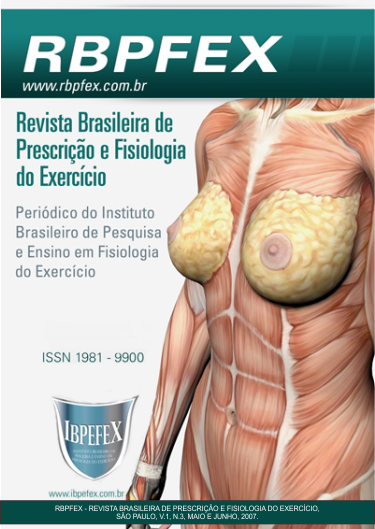The ideal age for the initiation of the training of force in the soccer
Abstract
In the last years research they come being carried through, with the intention to prove the efficiency and the benefits of the training of force in the collective sports, looking for to improve the performance of its athlete. The improvement of the power and the force in adult athletes in the soccer is today being integrant part of the program of physical preparation, with the intention to reach the totality of the athletically potential, demonstrating the benefits of the method. Some doubts appear when the applicability of the training of force for children and adolescents is argued who participate of a program of training in the categories of base of the soccer. Many children and young to the times do not reach the totality of its potentials as for the performance, therefore the stimulations to the times seem not to be enough, presenting with this skillful and motor deficiencies. Innumerable forms of if working force of attractive form for the categories of base in the soccer exist, searching benefits and preparing children and adolescents to support higher loads of work in superior categories. The benefits of the force training even go since prophylactic benefits of performance. This work of revision possess the objective to try to clarify these doubts and to tryto relate the benefits of the training of force in the categories of base of the soccer.
References
- Benedic, J.V,; Walter, L.B. Straining Characteristics and tensit Strength of Weneblancet Human Tem Dan. Biomechanics 1968,53/63
- Elliot, Bruce; Mester, Joachin. Treinamento no Esporte Aplicando a Ciência No Treinamento, Ed. Phorte, Guarulhos 2000.
- Falk, B.; Tenenbaum, G. The Efectiveness of Resistence Training in Children-Sports Med. 22:3.176-830,1996
- Fleck, e Kraemer. Designing Resistence Training Programs-Human Kinestc, EUA 1997
- Fleck, Stevens. Fundamentos do Treinamento de Força Muscular, Ed. Artmed, Porto Alegre, 1999.
- Gonzáles Baldino, Juan José. Fundamentos do Treinamento de Força e a Aplicação ao Alto Rendimento, Ed. Porto Alegre: Artmed , 2001
- Hamill, B.P. Relative Safety of Weightlifting and Weight Training Journal of Strength and Conditioning, Reserch. 8:53-57, 1994.
- Lazzoli, José Kawasoe.; e colaboradores. Atividade Física e Saúde na Infância e Adolescência-Sociedade Brasileira de Medicina do Esporte, VA. 4. Número. 4 Jul/Ago,1998
- Lillegard, W.A.; Mammon, E.N.; Willon, A.J.; Henderson, R.; Lewis, E. Lacey of Strength training in Pubescent to Eany Postubescent Males and Females.- Pediatric-Rehabil: 1,3:147-157, 1997- Sulsep
- Pfeifer. R.; Francis. R.S. Effects of Strength Training on Muscle Development in Prepubescent, Pubescent and Pospubescent Males: The Physical and Sports Medicine. V. 14, N. 9, P 134-143, 1986
- Ramsay, J.A.; Blimkie, C.J.; MacDougall. Strength Training Effects in Prepubescent Boys-Medicine Science Sports Exercise; 22(5)605-14,1990
- Risser, W.L. Musculoskelestal Injuries Cansed by Weigth Training-Guidelines for Prevetion-Clinical Pediatric. 29(6):305-310, 2000.
- Risso, Sidnei.; Lopes, Andrei Guilherme. Repensando o treinamento de força em crianças Pré-púberes, na faixa etária de 6 a 12 anos de idade-Universidade Estadual de Londrina CNPQ-PR. 2000.
- Siegal, J.A.; e colaboradores. The Efects of Upper Body Resistence. Trainig on Prebuscent Children-Pediatric Exercise Science, 1:145-154,1998.
- Webb, D.R. Strength Training in Children and Adolescents- Pediatrics Clin. North, AM:37(5):1187-1210,1990
- Weineck, Erlanger. Futebol Total: O Treinamento Físico no Futebol, Ed. Phorte Guarulhos, Sp 2000a.
- Weineck, Jurgen. Biologia do Esporte, Ed. Manole, SP 2000
- Weltman, e colaboradores. The Efects of Hydranic Resistence Strength Training in Pré Pubescent Muscles. Medicine Science Sports Exercise. (18)629-638,1986
- Weltman. Weigth training in Prepubescent Children; Physiologic benefect and Potential Demage. Advances in Pediatric Sports Slines. V. 3 Human Kinects 1989
Authors who publish in this journal agree to the following terms:
- Authors retain the copyright and grant the journal the right of first publication, with work simultaneously licensed under the Creative Commons Attribution License BY-NC which allows the sharing of the work with acknowledgment of the authorship of the work and initial publication in this journal.
- Authors are authorized to enter into additional contracts separately for non-exclusive distribution of the version of the work published in this journal (eg, publishing in institutional repository or book chapter), with acknowledgment of authorship and initial publication in this journal.
- Authors are allowed and encouraged to post and distribute their work online (eg, in institutional repositories or on their personal page) at any point before or during the editorial process, as this can bring about productive change as well as increase impact and impact. citation of published work (See The Effect of Free Access).






